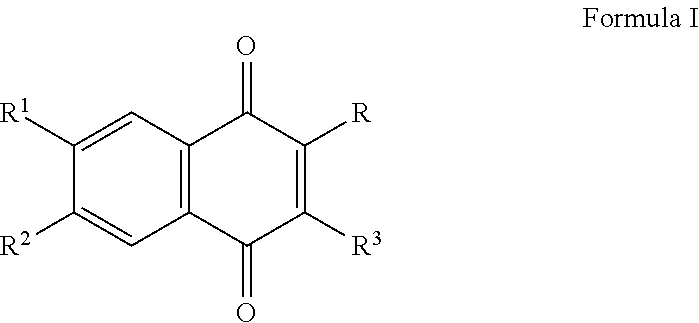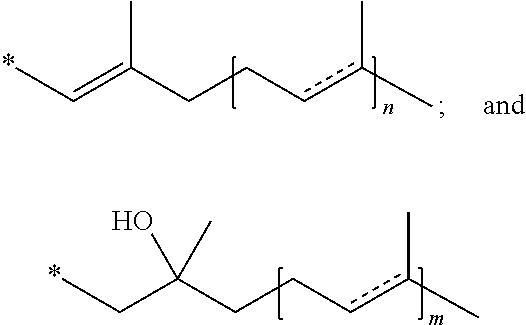Treatment of mitochondrial diseases with naphthoquinones
a technology of naphthoquinones and mitochondrial diseases, applied in the field of mitochondrial diseases with naphthoquinones, can solve the problems of affecting the function of the brain and muscles, affecting the function of the tissue or organ, and affecting the function of the body,
- Summary
- Abstract
- Description
- Claims
- Application Information
AI Technical Summary
Benefits of technology
Problems solved by technology
Method used
Image
Examples
example a
Screening Compounds of the Invention in Human Dermal Fibroblasts from Friedreich's Ataxia Patients
[0240]Test samples and solvent controls were tested for their ability to rescue FRDA fibroblasts stressed by addition of L-buthionine-(S,R)-sulfoximine (BSO), as described in Jauslin et al., Hum. Mol. Genet. 11(24):3055 (2002), Jauslin et al., FASEB J. 17:1972-4 (2003), and International Patent Application WO 2004 / 003565. Human dermal fibroblasts from Friedreich's ataxia patients have been shown to be hypersensitive to inhibition of the de novo synthesis of glutathione (GSH) with L-buthionine-(S,R)-sulfoximine (BSO), a specific inhibitor of GSH synthetase (Jauslin et al., Hum. Mol. Genet. 11(24):3055 (2002)). This specific BSO-mediated cell death can be prevented by administration of antioxidants or molecules involved in the antioxidant pathway, such as alpha-tocopherol, selenium, or small molecule glutathione peroxidase mimetics. However, antioxidants differ in their potency, i.e. the ...
example b
Screening Compounds of the Invention in Fibroblasts from Huntington's Patients
[0256]Compounds of the invention were tested using the screen as described in Example A, but substituting FRDA cells with Huntington's cells obtained from the Coriell Cell Repositories (Camden, N.J.; repository number GM 04281). The compounds were tested for their ability to rescue human dermal fibroblasts from Huntington's patients from oxidative stress.
[0257]Certain compounds of the present invention such as:[0258]2-hexyl-3-methylnaphthalene-1,4-dione;[0259]2,3-dimethylnaphthalene-1,4-dione;[0260]2,3-dimethoxynaphthalene-1,4-dione;[0261]naphthalene-1,4-dione;[0262]2-butyl-3-methylnaphthalene-1,4-dione; and[0263]2-methoxynaphthalene-1,4-dione;
exhibited protection against Huntington's with an EC50 of less than about 150 nM.
example c
Screening Compounds of the Invention in Fibroblasts from Leber's Hereditary Optic Neuropathy Patients
[0264]Compounds of the invention were screened as described in Example A, but substituting FRDA cells with Leber's Hereditary Optic Neuropathy (LHON) cells obtained from the Coriell Cell Repositories (Camden, N.J.; repository number GM03858). The compounds were tested for their ability to rescue human dermal fibroblasts from LHON patients from oxidative stress.
[0265]Certain compounds of the present invention such as:[0266]2,3-dimethylnaphthalene-1,4-dione;[0267]2,3-dimethoxynaphthalene-1,4-dione;[0268]naphthalene-1,4-dione;[0269]2-hexyl-3-methylnaphthalene-1,4-dione;[0270]2-butyl-3-methylnaphthalene-1,4-dione; and[0271]2-methoxynaphthalene-1,4-dione;
exhibited protection against LHON with an EC50 of less than about 150 nM.
PUM
| Property | Measurement | Unit |
|---|---|---|
| Molar density | aaaaa | aaaaa |
Abstract
Description
Claims
Application Information
 Login to View More
Login to View More - R&D
- Intellectual Property
- Life Sciences
- Materials
- Tech Scout
- Unparalleled Data Quality
- Higher Quality Content
- 60% Fewer Hallucinations
Browse by: Latest US Patents, China's latest patents, Technical Efficacy Thesaurus, Application Domain, Technology Topic, Popular Technical Reports.
© 2025 PatSnap. All rights reserved.Legal|Privacy policy|Modern Slavery Act Transparency Statement|Sitemap|About US| Contact US: help@patsnap.com



